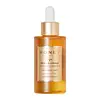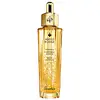What's inside
What's inside
 Key Ingredients
Key Ingredients

 Benefits
Benefits

 Concerns
Concerns

 Ingredients Side-by-side
Ingredients Side-by-side

Water
Skin ConditioningPentylene Glycol
Skin ConditioningGlycerin
HumectantMethyl Gluceth-20
HumectantPolyglycerin-3
HumectantNiacinamide
SmoothingButylene Glycol
Humectant1,2-Hexanediol
Skin ConditioningAlcohol
AntimicrobialPropolis Extract
Skin ConditioningOctyldodeceth-16
EmulsifyingDipropylene Glycol
HumectantMethylpropanediol
SolventLaminaria Japonica Extract
Skin ProtectingEclipta Prostrata Leaf Extract
Skin ConditioningHoney
HumectantAcrylates/C10-30 Alkyl Acrylate Crosspolymer
Emulsion StabilisingGlyceryl Polymethacrylate
Xanthan Gum
EmulsifyingTromethamine
BufferingPropanediol
SolventParfum
MaskingAdenosine
Skin ConditioningFructooligosaccharides
HumectantHydrogenated Lecithin
EmulsifyingBeta-Glucan
Skin ConditioningCynara Scolymus Leaf Extract
Skin ConditioningAvena Sativa Kernel Extract
AbrasivePolyquaternium-51
Skin ConditioningCamellia Sinensis Leaf Water
MaskingMelia Azadirachta Leaf Extract
Skin ConditioningMelia Azadirachta Flower Extract
Skin ConditioningCurcuma Longa Root Extract
MaskingTheobroma Cacao Seed Extract
AntioxidantDextrin
AbsorbentAcmella Oleracea Extract
Skin ProtectingHydrolyzed Hyaluronic Acid
HumectantOcimum Sanctum Leaf Extract
Skin ConditioningCorallina Officinalis Extract
Skin ConditioningButyrospermum Parkii Butter
Skin ConditioningPhenethyl Alcohol
MaskingEthylhexylglycerin
Skin ConditioningMaltodextrin
AbsorbentHydrolyzed Royal Jelly Protein
Skin ConditioningWater, Pentylene Glycol, Glycerin, Methyl Gluceth-20, Polyglycerin-3, Niacinamide, Butylene Glycol, 1,2-Hexanediol, Alcohol, Propolis Extract, Octyldodeceth-16, Dipropylene Glycol, Methylpropanediol, Laminaria Japonica Extract, Eclipta Prostrata Leaf Extract, Honey, Acrylates/C10-30 Alkyl Acrylate Crosspolymer, Glyceryl Polymethacrylate, Xanthan Gum, Tromethamine, Propanediol, Parfum, Adenosine, Fructooligosaccharides, Hydrogenated Lecithin, Beta-Glucan, Cynara Scolymus Leaf Extract, Avena Sativa Kernel Extract, Polyquaternium-51, Camellia Sinensis Leaf Water, Melia Azadirachta Leaf Extract, Melia Azadirachta Flower Extract, Curcuma Longa Root Extract, Theobroma Cacao Seed Extract, Dextrin, Acmella Oleracea Extract, Hydrolyzed Hyaluronic Acid, Ocimum Sanctum Leaf Extract, Corallina Officinalis Extract, Butyrospermum Parkii Butter, Phenethyl Alcohol, Ethylhexylglycerin, Maltodextrin, Hydrolyzed Royal Jelly Protein
Water
Skin ConditioningGlycerin
HumectantPolyglycerin-3
Humectant1,2-Hexanediol
Skin ConditioningAlcohol
AntimicrobialPolysorbate 20
EmulsifyingPentylene Glycol
Skin ConditioningMel
EmollientRoyal Jelly
Mannitol
HumectantCellulose
AbsorbentChlorphenesin
AntimicrobialParfum
MaskingPolyacrylate Crosspolymer-6
Emulsion StabilisingPropanediol
SolventTrisodium Ethylenediamine Disuccinate
Sodium Citrate
BufferingCitric Acid
BufferingBiosaccharide Gum-2
Skin ConditioningTocopheryl Acetate
AntioxidantMaltodextrin
AbsorbentAdenosine
Skin ConditioningCaprylic/Capric Triglyceride
MaskingAcrylates/Ammonium Methacrylate Copolymer
Synthetic Fluorphlogopite
Triethyl Citrate
MaskingCI 77891
Cosmetic ColorantSodium Benzoate
MaskingBiosaccharide Gum-1
HumectantSodium Metabisulfite
AntioxidantCI 77492
Cosmetic ColorantPotassium Sorbate
PreservativeCI 77491
Cosmetic ColorantHydroxypropyl Methylcellulose
Emulsion StabilisingTin Oxide
AbrasiveWater, Glycerin, Polyglycerin-3, 1,2-Hexanediol, Alcohol, Polysorbate 20, Pentylene Glycol, Mel, Royal Jelly, Mannitol, Cellulose, Chlorphenesin, Parfum, Polyacrylate Crosspolymer-6, Propanediol, Trisodium Ethylenediamine Disuccinate, Sodium Citrate, Citric Acid, Biosaccharide Gum-2, Tocopheryl Acetate, Maltodextrin, Adenosine, Caprylic/Capric Triglyceride, Acrylates/Ammonium Methacrylate Copolymer, Synthetic Fluorphlogopite, Triethyl Citrate, CI 77891, Sodium Benzoate, Biosaccharide Gum-1, Sodium Metabisulfite, CI 77492, Potassium Sorbate, CI 77491, Hydroxypropyl Methylcellulose, Tin Oxide
 Reviews
Reviews

Ingredients Explained
These ingredients are found in both products.
Ingredients higher up in an ingredient list are typically present in a larger amount.
1,2-Hexanediol is a synthetic liquid and another multi-functional powerhouse.
It is a:
- Humectant, drawing moisture into the skin
- Emollient, helping to soften skin
- Solvent, dispersing and stabilizing formulas
- Preservative booster, enhancing the antimicrobial activity of other preservatives
Adenosine is in every living organism. It is one of four components in nucleic acids that helps store our DNA.
Adenosine has many benefits when used. These benefits include hydrating the skin, smoothing skin, and reducing wrinkles. Once applied, adenosine increases collagen production. It also helps with improving firmness and tissue repair.
Studies have found adenosine may also help with wound healing.
In skincare products, Adenosine is usually derived from yeast.
Learn more about AdenosineAlcohol comes in many different forms. Different types of alcohol will have different effects on skin. This ingredient is usually an astringent alcohol.
These alcohols are drying on the skin. They may strip away your skin's natural oils and even damage your skin barrier. Astringent alcohols may also irritate skin.
Other types of astringent alcohols include:
According to the National Rosacea Society based in the US, you should be mindful of products with these alcohols in the top half of ingredients.
Any type of sanitizing product will have high amounts of alcohol to help kill bacteria and viruses.
Fatty alcohols come from plant oils such as coconut oil. These can help hydrate the skin and are non-irritating. Some fatty alcohols include cetyl and stearyl alcohol.
Learn more about AlcoholGlycerin is already naturally found in your skin. It helps moisturize and protect your skin.
A study from 2016 found glycerin to be more effective as a humectant than AHAs and hyaluronic acid.
As a humectant, it helps the skin stay hydrated by pulling moisture to your skin. The low molecular weight of glycerin allows it to pull moisture into the deeper layers of your skin.
Hydrated skin improves your skin barrier; Your skin barrier helps protect against irritants and bacteria.
Glycerin has also been found to have antimicrobial and antiviral properties. Due to these properties, glycerin is often used in wound and burn treatments.
In cosmetics, glycerin is usually derived from plants such as soybean or palm. However, it can also be sourced from animals, such as tallow or animal fat.
This ingredient is organic, colorless, odorless, and non-toxic.
Glycerin is the name for this ingredient in American English. British English uses Glycerol/Glycerine.
Learn more about GlycerinMaltodextrin is a polysaccharide. It is derived from starch such as rice, corn, wheat, or potato starch.
In food, Maltodextrin is used to improve the texture and thicken a product. Due to its structure, it can help create a gel texture. As an emulsion stabilizer, it helps keep the ingredients in a product together.
As a polysaccharide, Maltodextrin has moisturizing properties. Polysaccharides are a type of carbohydrate. The top layer of skin uses polysaccharides to retain water, keeping the skin hydrated.
Maltodextrin is water soluble and has a sweet taste.
Learn more about MaltodextrinParfum is a catch-all term for an ingredient or more that is used to give a scent to products.
Also called "fragrance", this ingredient can be a blend of hundreds of chemicals or plant oils. This means every product with "fragrance" or "parfum" in the ingredients list is a different mixture.
For instance, Habanolide is a proprietary trade name for a specific aroma chemical. When used as a fragrance ingredient in cosmetics, most aroma chemicals fall under the broad labeling category of “FRAGRANCE” or “PARFUM” according to EU and US regulations.
The term 'parfum' or 'fragrance' is not regulated in many countries. In many cases, it is up to the brand to define this term.
For instance, many brands choose to label themselves as "fragrance-free" because they are not using synthetic fragrances. However, their products may still contain ingredients such as essential oils that are considered a fragrance by INCI standards.
One example is Calendula flower extract. Calendula is an essential oil that still imparts a scent or 'fragrance'.
Depending on the blend, the ingredients in the mixture can cause allergies and sensitivities on the skin. Some ingredients that are known EU allergens include linalool and citronellol.
Parfum can also be used to mask or cover an unpleasant scent.
The bottom line is: not all fragrances/parfum/ingredients are created equally. If you are worried about fragrances, we recommend taking a closer look at an ingredient. And of course, we always recommend speaking with a professional.
Learn more about ParfumPentylene glycol is typically used within a product to thicken it. It also adds a smooth, soft, and moisturizing feel to the product. It is naturally found in plants such as sugar beets.
The hydrophilic trait of Pentylene Glycol makes it a humectant. As a humectant, Pentylene Glycol helps draw moisture from the air to your skin. This can help keep your skin hydrated.
This property also makes Pentylene Glycol a great texture enhancer. It can also help thicken or stabilize a product.
Pentylene Glycol also acts as a mild preservative and helps to keep a product microbe-free.
Some people may experience mild eye and skin irritation from Pentylene Glycol. We always recommend speaking with a professional about using this ingredient in your routine.
Pentylene Glycol has a low molecular weight and is part of the 1,2-glycol family.
Learn more about Pentylene GlycolPolyglycerin-3 is a 3-unit glycerin polymer.
Like glycerin, this ingredient is a humectant. Humectants help hydrate your skin by drawing water to it.
Having moisturized skin helps improve the skin barrier. Your skin barrier helps protect against irritants and bacteria.
Learn more about Polyglycerin-3Propanediol is an all-star ingredient. It softens, hydrates, and smooths the skin.
It’s often used to:
Propanediol is not likely to cause sensitivity and considered safe to use. It is derived from corn or petroleum with a clear color and no scent.
Learn more about PropanediolWater. It's the most common cosmetic ingredient of all. You'll usually see it at the top of ingredient lists, meaning that it makes up the largest part of the product.
So why is it so popular? Water most often acts as a solvent - this means that it helps dissolve other ingredients into the formulation.
You'll also recognize water as that liquid we all need to stay alive. If you see this, drink a glass of water. Stay hydrated!
Learn more about Water